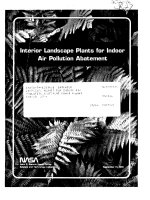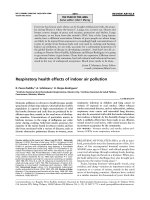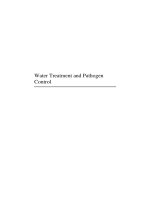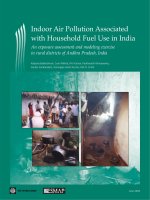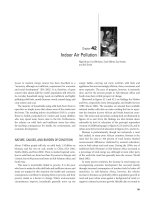Combined household water treatment and indoor air pollution projects in urban Mambanda, Cameroon and rural Nyanza, Kenya ppt
Bạn đang xem bản rút gọn của tài liệu. Xem và tải ngay bản đầy đủ của tài liệu tại đây (1.07 MB, 80 trang )
WHO/SDE/02.11
Englishonly
Combinedhouseholdwatertreatmentandindoorair
pollutionprojectsinurbanMambanda,Cameroonandrural
Nyanza,Kenya
Geneva2011
1
1
Photocredit(BruceNandShaheedA,2009)
Combinedhouseholdwatertreatmentandindoorairpollutionprojectsinurban
Mambanda,CameroonandruralNyanza,Kenya
©WorldHealthOrganization2011
Allrightsreserved.PublicationsoftheWorldHealthOrganizationcanbeobtainedfrom
WHOPress,WorldHealthOrganization,20
AvenueAppia,1211Geneva27,Switzerland(tel.:
+41227913264;fax:+41227914857;e‐mail:
).Requestsfor
permissiontoreproduceortranslateWHOpublications–whetherforsaleorfor
noncommercialdistribution–shouldbeaddressedtoWHOPress,attheaboveaddress(fax:
+41227914806;e‐mail:).
Thedesignationsemployedandthepresentationofthematerialinthispublicationdo
not
implytheexpressionofanyopinionwhatsoeveronthepartoftheWorldHealth
Organizationconcerningthelegalstatusofanycountry,territory,cityorareaorofits
authorities,orconcerningthedelimitationofitsfrontiersorboundaries.Dottedlineson
mapsrepresentapproximateborderlinesforwhichthere
maynotyetbefullagreement.
Thementionofspecificcompaniesorofcertainmanufacturers’productsdoesnotimplythat
theyareendorsedorrecommendedbytheWorldHealthOrganizationinpreferenceto
othersofasimilarnaturethatarenotmentioned.Errorsandomissionsexcepted,thenames
ofproprietary
productsaredistinguishedbyinitialcapitalletters.
AllreasonableprecautionshavebeentakenbytheWorldHealthOrganizationtoverifythe
informationcontainedinthispublication.However,thepublishedmaterialisbeing
distributedwithoutwarrantyofanykind,eitherexpressedorimplied.Theresponsibilityfor
theinterpretationanduseof
themateriallieswiththereader.InnoeventshalltheWorld
HealthOrganizationbeliable fordamagesarisingfromitsuse.
2
2
WHO/SDE/WSH/02.11
Englishonly
Combinedhouseholdwatertreatmentandindoorair
pollutionprojectsinurbanMambanda,Cameroonandrural
Nyanza,Kenya
ReportofamissiontoMambanda,CameroonandNyanza,Kenya
Carriedoutfrom10to18December 2009
Authors
AmeerShaheed
Consultant,Water,SanitationandHealthProgramme,WorldHealthOrganization,Geneva
NigelBruce
Consultant,InterventionsforHealthyEnvironments,WorldHealthOrganization,Geneva
Editor
MaggieMontgomery
TechnicalOfficer,Water,SanitationandHealthProgramme,WorldHealthOrganization,
Geneva
Acknowledgements
Theauthorsthanktheprojectofficersandhealthpromoters,
governmentofficials,small‐
scalebusinesspeopleandhouseholdrespondentsinCameroonandKenyawhoofferedtheir
timeandexpertisetoinformthisevaluation.Inaddition,appreciationisextendedtoall
thosestakeholderswhohelpedinitiatethesehouseholdenvironmentalhealthintegration
projectsandcontinuetocarryoutthisimportantwork.
3
3
TABLEOFCONTENTS
EXECUTIVESUMMARY 6
1.BackgroundtoRFP 6
2.EvaluationTermsofReference(ToR)andmethods 6
3.CountryReports 7
4.Overallstrategicissuesandrecommendations 16
5.Nextsteps 17
1.INTRODUCTION 20
1.1Projectoverview 20
1.2EvaluationTermsofReference 20
1.3Visitschedule 21
1.4Evaluationmethods 21
1.5Briefreviewofliterature 21
1.5.1Effectivenessof
HWTS 21
1.5.2Effectivenessofimprovedsolidfuelstoves 22
2.COUNTRYREPORT–URBANMAMBANDA,CAMEROON 24
2.1Countrybackground 24
2.2Projectorganizationandmanagement 24
2.3Educationandproductpromotion 27
2.4Interventionefficacy,effectivenessandefficiency 28
2.4.1Householdwatertreatment 28
2.4.2Impr ovedstoves:reductionofhouseholdsolidfuelairpollution 32
2.5Financeand
loanarrangements 35
2.6Addedvalueofintegrateddelivery:synergies 35
2.7Recommendedareasforfurtherresearch 37
2.8Scaling‐up 38
2.8.1Locallevel 38
2.8.2Largerscale(city–national) 39
2.9Discussionandconclusions 40
2.9.1Conclusions 40
2.9.2Data 43
2.9.3Finalcomments 44
3.COUNTRYREPORT–RURALNYANZA,KENYA 45
3.1Countrybackground 45
3.2Project
overview 46
3.3.Projectorganisationandmanagement 48
3.4Education(health),productpromotionandfinance(loans) 49
3.5Interventionefficacy,effectivenessandefficiency 52
3.5.1Householdwatertreatment 52
3.5.2Impr ovedstoves:reductionofhouseholdsolidfuelairpollution 55
3.7Evaluationresearch 62
3.8Scaling‐upandintegrationwithgovernment 63
3.9Discussionandconclusions 65
4.SYNTHESISOF
EXPERIENCEFROMCAMEROONANDKENYA 68
4.1Projectfundingandorganisation 68
4
4
4.2Products 68
4.3Educationandpromotion 69
4.4Sellingofproducts 69
4.5Sustainabilityandscalingup,exitstrategy 70
4.6Synergy 70
4.7Researchandevaluation 70
5.RECOMMENDATIONANDNEXTSTEPS 71
5.1Specificrecommendationsforcountries 71
5.1.1Cameroon 71
5.1.2Kenya 72
5.2Strategicrecommendations 73
5.3Follow‐upWorkshop 74
5.4Issuesforfurtherresearch 74
5.5
Futureimplementation 75
6.REFERENCES 76
ANNEX1Visitschedule(December2009) 78
ANNEX2Evaluationtopics/questions 79
5
5
ABBREVIATIONS
ACMS AssociationCamerounaisedeMarketingsociale(SocialMarketing
AssociationofCameroon)
ALRI AcuteLowerRespiratoryInfection
AQG AirQualityGuidelines
GTZ GesellschaftfürtechnischeZ usammenarbeitung(GermanTechnical
Cooperation)
HAP HouseholdAirPollution
HHE HouseholdEnergy
HWT Householdwatertreatment
HWTS Ho useholdwatertreatmentandsafestorage
IAQ IndoorAirQuality
ITN Insecticidetreatednets
LP Liquefiedpetroleum
JMP WHO/UNICEFJointMonitoringProgram
MMS MambandaMultiStove(Cameroon)
NGO Non‐governmentalOrganization
NICHE NyandoIntegratedChildHealthandEducationProject
PCIA PartnershipforCleanIndoorAir
PSI PopulationServicesInternational
RFP Requestforproposals
SWAP SafeWaterandAIDSProject(KenyanNGO)
SWAp Sector‐wideapproach(KenyanGovernment)
UNICEF UnitedNationsChildren’sFund
WG WaterGuard®(“Sur’Eau”inFrench)
WHO WorldHealthOrganization
6
EXECUTIVESUMMARY
1.BackgroundtoRFP
In2007,theWorldHealthOrganization(WHO)issuedarequestforproposals(RFP)onthe
integrationofIndoorAirQuality(IAQ)andHouseholdWaterTreatment(HWT)atthe
householdlevelinAfrica.Globally,theburdenofill‐healthinAfricaduetounsafedrinking‐
water,inadequatesanitationandpollutedindoorair
standsoutprominently.AmongAfrican
childrenunder5yearsofage,18%ofalldeathsareduetodiarrhoea,and17%topneumonia
(UNICEF/WHO,2009).Around40%ofthesepneumoniadeathscanbeattributedtoindoor
airpollution,andapproximately88%ofdiarrhoeadeathstoinadequatewater,sanitation,
andhygiene
(WHO,2007).
Theaimsofthisinitiativewere:
1. Toexplorewhetherornotitispossibletoachievesynergiesandeconomiesofscaleby
linkingHWTandIAQinterventions
2. Toexaminethepotentialforexpansionandscalingupintheimplementationofprojects
combiningtheseinterventions
3. To
documentintegrationmodelsfortheseinterventions
4. Toexaminetheadded‐valueofintegratingthesetwoapproaches,inawaythat
contributestoanimprovementinhealthoutcomes,aswellassustainabilityandadoption
ofuse.
Followingappraisaloftheproposalsreceived,twoprojectswereselected,oneinurban
Douala,
Cameroon,thesecondinruralNyanza,Kenya.Abriefoverviewofeachprojectis
providedinthecountryreportsectionsinthemainreport.
2.EvaluationTermsofReference(ToR)andmethods
WHOprojectsupportintheoverallmanagementplanmadeprovisionsforanevaluationvisit
toeachcountry.ThesewerecarriedoutinDecember2009bytwoWHOConsultants,Mr
AmeerShaheed(CameroonandKenya)andDrNigelBruce(Kenya),withthefollowingToR:
1. Preparebackgroundinformationandcompilecontextualinformation
ontheareas/study
communitieswithrespecttowatersupply/quality,householdfueltypeandsupply/IAQ
(subjecttoavailability)andrelatedhealthdata(diarrhoea,acutelowerrespiratory
infection(ALRI))
2. Toconductafield‐visittothetwoprojectsinCameroonandKenya,andperformabasic
evaluation
3. Prepareacomprehensive
factualaccountofprojectactivitiesandoutputs,describingthe
experienceofresidents,projectstaffandotherrelevantkeyinformants(e.g.local
government,partnerorganizations)concerningprojectdelivery,achievements,problems
andissues,andconcerningfutureprospectsforthiscombinedenvironmentalhealth
approachtargetedathouseholds.Particularemphasisshouldbegiventoassessing
the
addedvalueoflinkingdrinking‐watersafetyandindoorairquality.
7
Themethodsusedfortheevaluationdrewontechniquesofrapidappraisal,involving(i)
reviewofDocumentation(allavailableprojectdocumentation,countrystatisticaldata,
relevantpublishedpapersandreports;(ii)Interviewswithkeyinformants(projectstaff,
residents/usersoftheproductsandservices,andotherstakeholders),and(iii)Observation
(projectmanagementand
procedures,households,photographs).Interviewswererecorded
bymanualnote‐taking,andres ponsessynthesizedusingasimpleformofframework
analysis.ThebackgroundpaperintheRFPbyClasenandBiran
(2007)whichproposed
criteriaonpotentialsynergiesandantagonisms,alsocontributedtostructuringthe
evaluation.
3.CountryReports
CAMEROON
Localsituation
Cameroonisacountryof18.2millionpeople.Meanlifeexpectancyatbirthis50/52years
(m/f),andunder‐5mortalityis149/1000livebirths.Diarrhoeaaccountsfor16.4%ofunder‐5
deaths,andpneumonia,for20.4%
(WHO,2009).Accordingto2008figures,anestimated
92%ofurbanCameroonhasaccesstoan"improved"drinking‐watersourceasdefinedbythe
WHO/UNICEFJointMonitoringProgramme(WHO/UNICEF,2010).This doesnotg uarantee
safewaterhowever,andalargeproportionofsuchsourcesmaybesubjecttocontamination
,
especiallythroughunsafewaterhandlingandstorage
practices.Additionally,56%ofurban
areaslackaccessto“improved”sanitation(WHO/UNICEF,2010).Regardingurbanfueluse,
approximately52%consistsofwoodandsawdust,25%ofLPGgas,5%ofcharcoal,and13%
ofkerosene(WHO,2010).
TheprojectwasspearheadedbytheGermanTechnicalCooperation(GTZ)inCameroon,in
Mambanda,asemi‐formalsettlementinDouala,Cameroon'slargestcity.Situatedonan
island,accesstowaterislimited,andgroundwaterisbrackish,containingheavyiron
deposits.Furthermore,thepoorsystemofpipelinesandmanagementoftreatmentplants
resultsincontaminated,unsavoury,andinsufficientdrinking‐water.Fueluseconsisted
primarilyof
woodandsawdust,andtoalesserextent,charcoalandLPgas.
Projectactivityandachievements
Projectobjectives
Theprojectpilotedamethodofintegratingthedeliveryofawatertreatmentdevicewith
improvedstoves.Itwassetuptoinvestigatethepotentialaddedvalueofcombining
environmentalhealthinterventions.
Itshealthaimswere“toreducechildmorbidityand
mortalityfromdiarrhoealandrespiratorydiseases”
(GTZ,2008).GTZalsosawthisasan
opportunitytofollowfromtheirearlieractivitiesinwater,sanitation,andhygienein
Mambanda.
Projectfunctioning
Theprojectwascoined“SmokeandDrinking‐water”,whichsawthejointimplementationof
awatertreatmentproduct“WaterGuard®”(WG)andanimprovedstove“Mambanda
MultiStove”
ineightblocksofthesettlement.WGisasodiumhypochloritesolutionusedfor
disinfectingdrinking‐wateratthepoint‐of‐use,popularinmanyAfricanandAsiancountries
andemergency‐reliefoperations.TheMambandaMultiStove(MMS)isauniqueimproved
stove,designedbyGTZ,aimingtoreduceindoor‐air‐pollution
andefficientlycombust
8
multipletypesoffuel.TheprojectwassettorunfromJune2008toNovember2009.Itwasin
successiontoGTZ’searlier“WaterandSanitation”project(2006‐2008),inthecontextof
whichwell‐chlorinationandsanitationinterventionswereconductedinseveralpartsof
Douala,includingMambanda.
Projectstructure
TheGTZenvironmenthealthofficerinDoualawastheoverallprojectcoordinator.He
employedtwoprojectmanagers,whowereinchargeofallfieldactivities.TheAssociation
CamerounaisepourleMarketingSocial(ACMS),anot‐for‐profitorganisation,providedWG
andsocialmarketingexpertisetotheproject.Localweldersweretrained
byGTZtoproduce
theMMS.Theprojectteamincludedfourlocalg roups:(1)watervendors,whosoldwaterat
communalpumpsalongwithbothinterventionproducts;(2)localshopkeeperswhosold
WG;(3)communityworkerswhoengagedwiththebeneficiariesandsoldbothproducts;and
(4)localhealthcentre
staff.
Expectedoutputs
Ofthetargetpopulation,90%wasexpectedtohaveaccesstosafedrinking‐waterand60%to
beusingfuelefficientstovesbytheendoftheproject.Theintegratedapproachwas
expectedtobringoverallefficiency,particularlyincostandtime.Theyexpected
improvementsincommunity
healtheducation,andgreaterownershipoftheproject
amongstbeneficiaries.
Evaluationresults
Itisimportanttonotethatthefocusofthisevaluationwastostudythepotentialfor
integratedhouseholdinterventions,asopposedtotheeffectofthespecificinterventionsin
question.Theevaluationwasconductedbyrapidappraisal
methods,includingkeyinformant
interviews.AllquantitativedatawasobtainedfromstudyingreportssubmittedbyGTZafter
ourevaluation.
Aseriesofevents–mostlybeyondthecontroloftheprojectmanagers–affectedtheproject
overitscourse.Thisledtosomedifficultiesintheinterpretationofavailabledata
onthe
projectimplementationandimpacts,issueswhicharediscussedfurtherinsection2.2.Dueto
this,andtoafocusthatwasmoregearedtoassessingintegrationperse,ourconclusionsand
recommendationsdrawsubstantiallyonthevisit,withsupportfromreportsanddatawhere
thisisavailable.
The
followingarekeyresultsthatemergedfromtheevaluationexercise:
Communityresponse
Therewasclearsupportfortheinterventionamongstthestudygroupandneighbouring
residents.Bothbeneficiariesandprojectimplementersfoundtheintegration ofhealth
interventionstobeefficientandeffective.Asignificantlyraisedawarenessoftheprojectand
generalhealthwasreported.Thegreatestcomplaintregardedstoveprices,whichweretoo
expensiveformostmembersofMambanda,andsoldbestwhensubsidized.
9
Implementerbenefits
Themainimplementerbenefitsincludedconsolidatingawarenesscampaigns,
implementationanddatacollection,reachingagreatertargetaudienceandpromoting
preventiveactionforbothALRIanddiarrhoeawithasingletheme(thekitchen).
Targetpopulationbenefits
Twoproductsbeingpromotedatonce(timesaved),amoreconsolidated/holistic
understandingof
healthandapotentiallymoreenduringmessagewerethekeybenefitsto
theprojectbeneficiaries.
Trainedcommunityworkers
Thetrainedlocalcommunityworkers,whopromotedandsoldtheproductsdirectlyto
households,playanimportantroleingeneratinginterestanddemandfortheproducts .
Theyimpartedafeelingoffamiliarity
andtrust,andbridgedthedividebetween
implementersandcommunity.
Quantitativeimpact
Theshortdurationofthispilotstudydidnotallowforcollectingsufficientdatatoquantify
theimpactonhealthfromtheinterventiontechnologies.Itwasalsonotpossibleto
numericallydemonstrateanincreaseinsalesanduptake
specificallyduetothesynergy.
Therewaslittledataoncompliance,hardmeasuresofuptakeorof‘treatment’effects(e.g.
chlorineresiduals,airpollutionmeasurements),orhealthimprovementsinrelationtoeither
product.However,reporteduseofWGforwatertreatmentrosefrom1to34%forthe
interventionhouseholds,
andtherewasanincreasefrom1to12%inMMSstoveusein
thosesamehouseholds.Duringtheproject220stovesweresoldtoindividualslocatedinthe
interventionareawhile442weresoldtoindividualsoutsidetheintervention.Althoughthe
reasonsforgreatersalesoutsideMambandahavenotbeen
specificallyinvestigated,
anecdotalaccountsindicatethatthestoveswereunaffordableinMambanda,evenwiththe
30%subsidy.However,wealthierhouseholdsoutsideMambandacouldaffordthestoves
andfoundthemtechnologicallysuperiortootherstovesonthemarket.
Discussion
Thecombinedapproachofenvironmentalhealthinterventionswasreceivedwellby
implementers
andbeneficiariesalike.Keygainsnotedbyimplementersincludedefficiency
onseveralfronts(e.g.numberofcommunityinterventions,time,cost),andimprovements
throughconsolidatedpromotion.Keydifficultiesaroseinrespectofaffordabilityofthe
interventions(principallythestove),funding,andinmanagingprojectsustainabilityinthe
faceofchallenginglocal
circumstances.PricewasanimportantbarriertothesaleofMMS,
whichneverthelessbenefitedfromconsiderableawarenessandinterest.Theprojectwould
havebenefittedfrommoresystematicanddetailedmonitoringandevaluation.
Inconsideringthedeliveryofcombinedinterventions,wefoundananalysisofmotivational
factorstobeimportant.The
indoorairqualitycomponentoftheinterventionsawperceived
benefitssuchasefficientfueluse,acleanercookingenvironmentandvisiblesmoke
reduction.Useofwatertreatmentontheotherhandseemedmoreduetoaraised
awareness,andhealth‐andhygiene‐basedbehaviourchange.Thesetwointerventions,with
differentmotivations,
werepackagedunderacommontheme:thekitchen.Thistheme
10
workedwellinthegivensetting,andeffectivelyjoinedthetwointerventions.Recognizing
motivationalfactorsandfindingeffectivepromotionalmessages/bannersthusseemedtobe
apertinentconsideration.
Oneofthemostimportantlinksinrespectofbehaviourchange,impartingeducation,and
puttingtheoryintopractice,wastheroleofthe
localcommunityworkers.Theircredibility
andknowledgeofthelocalareawasessentialtoeffectivelytargetindividuals,valuesand
behaviours.Theyalsoformedanimportantlinkbetweenthecommunity,projectteam,and
otherstakeholders.Ofmostinterest,theworkerswereallassociatedwitha“brand”of
sorts,knownas“MamiPegna”.
“MamiPegna”(roughlytranslatedas“MotherIdeal”)
representedavillagewomanwhoembodiedvirtue,andgoodlivingpractices(e.g.hygiene,
health,andwithconnotationsofgoodmorals).Thecommunityworkerswereidentifiedas
MamiPegna,andworecustomizedt‐shirtswithherlogo(seeSection2),andwerewell‐
known
acrossMambanda.Thisunifyingconceptwasaneffectivemechanismtobindboth
(andseveralother)interventionstogether.
Thespecificimpactofthetechnologiesthatwerepromotedrequiresfurtherinvestigation,
asdatacollection,extenuatingcircumstances,andtimewererestrictingfactors.Fromour
analysis,greaterawarenessanduptakeofbothproductswasobserved.
Interviewsrevealed
greaterhealthawareness,andhygienepractices.Beneficiariesreportedimprovedhealth
fromusingWG,andweregenerallysatisfiedwiththeproductdespitetheill‐fittingbottle
caps(discussedfurtherinSection2.3).Indeed,themajorityofcommunitymembers
interviewedindicatedawishtohavecontinued,andforgreateraccess
tosuchproducts.
Althoughpricewasamajorbarrier,theversatilityandtechnologicalvalueofthestovemade
itparticularlypopular,withafewstovesevenbeingsoldoutsideDouala.
Regardingnextstepsforinvestigatingintegratedmodels,twoprioritiesemergedin
particularfromtheMambandawork.Thefirstwasto
carryoutfurtherassessmentsofsuch
projects,designedtoteaseoutspecific“addedvalue”ofjointprojectsoverseparateones.
Thesecondwastoclearlydefinethescopeofintegratedinterventionprogrammesand
identifytheirspecificcomponents,determiningthespecifictypesandnumberof
interventionsthatwouldbeappropriateforgiven
settings.
Thisprojectalsoillustratedtheimportanceofdevelopingworkablegovernanceframeworks
forscalinguphousehold‐andcommunity‐levelprojects.Theseneedtoincludearolefor
governmentalongsidemultiplestakeholders(includingprivatecompanies)downtothe
communitylevel.Itisalsoimportanttoconsiderdifferentfinancialmodelstomake
suchan
integratedapproachsustainableforallpartiesinvolved(notablysuppliersandlow‐income
end‐users).
PrincipalrecommendationsfortheMambandaproject
Themajorbenefitsofthissynergisticapproachareapplicabletoarangeofenvironmental
healthinterventionsatthehouseholdlevel.Thefollowingarespecificrecommendationsfor
improvingand
scalingtheprojectinMambanda.Inordertoexpandactivities,thefollowing
threemajorrecommendationsaregiven:
11
Overallfollow‐up/projectre‐establishment
Anassessmentofthecurrentsituation,giventhecessation(atthistime)ofthe
projectwouldbeanappropriatefirstaction.Initialtaskswouldincludeascertaining
whichofthepartnerorganizationsarestilloperational,otheravailablepartners,and
thestatusoftheformerMambandawater
andsanitationcommittee.
Supportforalocalwater,sanitation,andindooraircommittee
Approachestoinvolveallstakeholdersinaviablemannerarerequired.Forits
duration,thecommunitycommitteeseemstohavebeensuccessful.Giventhe
householdleveloftheseinterventions,suchamodelmaystillbeappropriate.
The
activeparticipationoflocalgovernmentwouldalsobeafactortoinclude,together
withotherhigher‐levelsupport.
Resourcemobilization/financialmechanisms
Alongwithgovernance,financeisanimportantelementtosustainability.Solutionsto
maketheinterventionfinanciallyviableareneeded.Inaddition,reducingthecapital
costtothe
householdswhileprovidingongoingincentivestolocalimplementersand
suppliersiscrucial.
FutureassessmentstofurtherinvestigatetheissuesexploredinCamerooninclude:
CompliancewithWG,usingmeasurementsofchlorineresiduals
MMSuptake(includingdemographicsofinterventionhouseholds)
EfficacytrialsofMMSincludingemission,householdairpollution
levelsandfuel
efficiency,andpossiblealterationstoimproveperformanceandreduceair
pollution.
EpidemiologicalstudiesforbothWGandMMSusers(withappropriatecontrol
groups),asalongertermevaluationobjective.
KENYA
Countrysituation
Kenyaisacountryof38.8millionpeople,ofwhich68%areclassifiedas
rural(WHO/UNICEF,
2010).Neonatalmortality(33/1000livebirths )andunderfive‐mortality(128/1000live
births)arestillrelativelyhighanddiarrhoeaandpneumoniaarethepredominantcausesof
deathinyoungchildren(WHO,2010).Thesetwoillnessesareresponsibleforaround16%
and17%ofthesedeaths,respectively,in2004
(UNICEF/WHO,2009).
ThemostrecentJMPdataindicatesthatinruralKenyaoverhalf(52%)ofhouseholdshad
accessto"improved"watersourcesin2008,whichissubstantialincreasefrom30%in1990
(WHO/UNICEF,2010).ThemostrecentfiguresfromtheWHOhouseholdenergydatabase
showthatin2003almostall
(96%)ofruralhomesusedsolidfuelsforcooking,mostofwhich
iswood(85%),withsomecharcoal(10%)(WHO,2011).Lessthan5%ofthesesolidfuelusers
havestoveswhichventsmokethroughachimney.
Giventhissituationwithrespecttohealthstatusandtowaterandenergy
accessinKenya,
togetherwiththeimportanceofbothsafewaterfordiarrhoeapreventionandreductionof
solidfuelsmokeexposureforpneumoniaprevention,effectiveinterventionsaddressingboth
12
oftheseproblemsarehighlyrelevant.Thepotentialofsuchprogrammesforscalingupisof
vitalimportance,ifinitiativessuchastheprojectevaluatedherearetomakeasubstantial
contributiontoreducingthepopulationdiseaseburdenarisingfromunsafewaterandsolid
fueluse.
Kenyaprojectactivityand
achievements
Projectobjectivesandexpectedoutputs
ThefollowingobjectivesandoutputswerestatedintheSWAPprojectRFPapplication:
Goal:
Thegoaloftheprojectistoreducetheriskofdiarrhealdiseasesandrespiratoryinfectionsby
motivatingtheuseofhouseholdwatertreatment(HWT)productsandinnovativestovesfor
improvementofindoorairquality(IAQ)inruralKenyanvillages.
Objectives:
DemonstratetheintegrationofHWTandIAQinto10of60villagesenrolledinanongoing
programmotivatingthepurchaseanduseofhealthinterventionsthroughsocialmarketing,
communitymobilization,andmicrofinance
MotivatepurchaseandregularuseofHWTproducts:
a) IncreaseuseofHWTproductsfrom15to40%ofhouseholdsin10intervention
villages
b) Pre‐filtrationofwaterwithsimplesandfiltersinbucketsin25%ofhouseholdsin10
interventionvillagesrelyingonturbidsources
Motivatethepurchase,production,installation,andadoptionofIAQtechnologies(eitherthe
RocketStove orJikoKisasaStove)in30%ofhouseholdsin10interventionvillages
Evaluateprogrammaticapproaches,adoptionprocesses,andaspectsrelatedtothe
maintenanceandcontinueduseoftheinterventions.
Projectstructure
TheprojectisrunbyaKenya‐basedNGO,theSafeWaterandAIDSProject(SWAP),basedin
Kisumu.AlthoughtheworkofSWAPcoversmostofNyanzaprovince(andapartofwestern
Kenya),thecurrentprojectisrestrictedtoNyandodistrict,southofKisumu,borderingLake
Victoria.Twomaincomponentstotheprojectareactivityevaluatedhere:
1. Thedeliveryofeducationandproducts(severalwatertreatmentandstorage
products,improved‘Upesi’stoves,insecticidetreatednets,andotherproducts
includingnutritionalsupplements)tohouseholds,usingacommercialmodelthat
allowsamodestprofitmarginforthe
vendors/educators.
2. AnevaluationstudymanagedbyCDCandSWAPstaff,theNyandoIntegratedChild
HealthandEducationProject(NICHE),covering60villagesofNyando,ofwhich10
receivedpromotionoftheintegratedHWTSandHHEinterventions.Theresearch
componentincludessurveysandbi‐weeklysurveillance,withassessmentof
interventionuse,
waterquality(chlorineresiduals,microbiology),indoorairquality,
andthemainhealthoutcome(diarrhoea).
13
Thisisawell‐managedproject.Itreliesonvendors,usingasustainablecommercialmodel
supportedbylow‐interestloansandinnovativeeducationalmethodstoempowerlow‐
incomehouseholdswithknowledgeabouthowvariousproductscanimprovehealthof
families,andencouragesadoptionthroughexample.
Projectfunctioningandachievements
The
vendors,localmembersofthecommunitiesdrawnfromHIVsupportgroupsandother
communityselfhelpgroups,areessentiallyrunningsmall‐scalebusinessoperations
facilitatedby(relatively)low‐costloans,andarekeytothefunctioningandsuccessofthis
project.Theyworkthroughcommunitymeetingsandschools,andalsodirectly
byhouse‐to‐
housevisits,whilesomealsosellincommunitykiosksandpharmacies.TheSWAPvendors
areofferedtrainingonsafewaterandbusinessskillstohelpthemtobecomemoreefficient
inmanagingtheirsmallscalebusinessesincludingsellinghealthproducts.
Thepromotionofproductsiscommerciallysustainable
asthesearesoldatcostwithasmall
mark‐upforthevendors,althoughthisisepisodicallycompromisedbyfreehandoutsby
otheragenciesofwatertreatmentproductsduringfloodsandothercrises.Overall,this
appearstobeaneffectiveandrobustmodelforsustainabledelivery.LikeallsuchNGO
‐led
activitieshowever,itwasnotentirelyclearhowwellthissystemwould‘survive’ifSWAP
fundingandkey,highlycompetentpersonnelwerenolongermanagingtheprogramme.
Vendorsareverycommitted,andrecognizecommunitydemand,butareunsurewhether
theywouldstillbeabletoaccesstheproducts.The
productsthemselveshavethepotential
toimpactonarangeofhighprioritydiseaseconditionsforchildsurvivalinKenya,namely
pneumonia(Upesistoves),diarrhoea(arangeofHWTSproductsandhand‐washingsoaps),
malaria(ITNs)andunder‐nutrition(Sprinkles).
Watertreatmentandstorage
TheHWTSproductscanbeexpected
tobeefficacious,buteffectivenessdependson
complianceineverydayuse.Furtherdataanalysisisneededtocompletethepicture,but
resultsavailabletodateshowcomplianceacrosstheNICHEareatobemoderate,reachingat
best66%reporteduseand57%confirmedbychlorineresidualtestinginthe10integrated
projectvillagesamongimprovedstoveusers.Onthebasisofthesedata,theprojecthas
reached(andexceeded)thestatedgoalforHWTS.
Thislevelofcompliancemayhoweverberelativelygood,intermsofwhatcanbeachievedin
practicewithHWTS.Althoughcomplianceappearstobehighestwhere
combined
interventionshavebeenpromotedandadopted,thisneedsfurtheranalysis,adjustingfor
socio‐economicandotherconfoundingfactors.Itisalsoimportanttotakeintoaccountthe
effectofparticipationinastudywithfrequenthomevisitswhichmayinflatecomplianceina
non‐sustainableway.
Improvedstoves
The
authorsarenotawareofanypriorstudiesoftheefficacyoftheUpesistoves,specifically
intermsofHAPreductionsinideal(‘test‐house’)circumstances.However,resultsfrom
testingofindoorairpollutionlevelsinthecurrentproject(repeatedearlyin2010)
demonstrateverymodestreductionsinPM
2.5
of10‐20%atbest.However,strongerevidence
ofsavingsinfuelwoodofnearly30%wasreported.Basedoneverydayexperienceinthe
14
project,however,thesestovesappeartobewell‐likedandwell‐used,andarereportedto
savewood,reducesmokeandtheconsequentirritation,cough,headaches,etc.,aswellas
thelevelofsootinthekitchen.Womenhavere‐organisedtheirkitchensinresponsetothis,
bringingpotsandother
utensilsmuchclosertothestove.Thereasonsforthisinconsistency
betweenfieldexperience(reportedreductionsinsmokeandirritation)andtestfindings(for
PM
2.5
)arenotclear,asreductionsinambientkitchenPM
2.5
ofsomewherearound40‐50%(at
least)mightbeexpectedgiventhereportedimprovementsinthekitchenenvironment.The
projectteamusedanestablishedprotocolandequipmentformakingthemeasurements.
Informationonthenumbersofstovesadoptedineachcommunity,andhencelevel(%)of
uptake,wasnotreported
acrossthestudyareaoravailabletous(althoughthesedatashould
beavailabletotheproject).Itisthereforenotpossibletocommentonwhetheradoptionhas
metthetargetsetintheprojectobjectives.Whileeffectivenessofthestovesremainsopen
toquestionandwillbefurtherassessed
oncethenewmeasurementresultsareavailable,
themodelofpromotionandsaleofacook‐stoveproductthatiswell‐likedandusedisan
importantachievementandofvalueforthefutureoftheproject.
Synergies
TheapproachofcombiningthepromotionanddeliveryofHWTSandHHE
productsmetwith
acrosstheboardpositiveresponses.Itappearsmorecost‐effectivethanifthesame
productswerepromotedthroughseparateprogrammes.Combineddeliverymayalso
achievehighercompliance,butthisdoesneedfurtheranalysis.Therewerenosubstantive
concernswithanyofthecriteriaidentifiedfromthebackgroundreview
paper.
Impactonhealthoutcomes
Analysisoftheresultsoftheimpactsoftheinterventionsondiarrhoeaandpneumonia
incidenceisawaited.Itcanbeexpectedthatthereportedlevelofcompliancewithwater
treatmentwouldhavesomeimpactondiarrhoea,particularlywherethehigherlevelshave
beenreached.On
theotherhand,theverymodestreductioninPM
2.5
levelsrecordedforthe
Upesistovewouldnot(ifconfirmed)beexpectedtoleadtosubstantialreductionsinriskof
pneumonia.
Sustainabilityandscalingup
Withrespecttothetwolinkedissuesofsustainabilityandscaling‐uptheoutcomeofthe
evaluationalsoispositive,althoughbothdependtosome
degreeatleastontheexistence
andmodusoperandiofSWAP.Thevendorsspokentosaidthattheywerecommittedto
continuingtheirwork,evenifSWAPceasedoperations,butonlyiftheycouldstillobtainthe
products.FromtheperspectiveoftheSWAPmanagement,thevendorsarestilldependent
on
SWAP’ssupportwithtraining,followupvisits,supplyofproducts,motivatingthemwith
incentivesandsoon.SWAPitselfisalsostilldonordependent,andhasrecentlydevelopeda
businessplantoraiseitsownincome.However,giventhefactthatSWAPoperatesasimilar
methodologyacrossitswholearea
ofoperationsfordeliveringthewatertreatment,ITNs
andother(original)setofproducts,itdoesseemreasonabletoassumethatdeliveryofthese
plusthestoveswouldalsobepossibleacrossthismuchlargerarea.
Todate,scalingupoftheimprovedstovesacrossthiswiderareahasbeen
veryslow,dueto
theneedtoscaleupproduction,andalsofortrainingofinstallers.Considerationalsoneeds
15
tobegivennowtotheimplicationsoftheresultsoftheUpesistoveevaluation,since
althoughthestoveiswell‐liked,affordableandclearlysavesfuel,thereductionsinkitchen
PM
2.5
areunsatisfactoryintermsofthehoped‐forhealthbenefits.Theprojectneedsto
examinealternativestoveoptionsforthispurpose,whichcouldbepromoted,atleast
initially,alongwithcontinuedpromotionoftheUpesi.Despitethisquestionregardingthe
mosteffectiveandappropriatestovetechnology,itdoesseemthat
thereispotentialtoscale
upthedeliveryapproachacrossaconsiderablylargerpopulation.
Coordinationwithgovernmentandotheragencies
In2009,SWAPjoinedHENNET,anationalnetworkingorganizationforNGO’sandFaith
BasedOrganizationwhichwasestablishedin2005andhas77members.Themissionof
HENNETisto
stimulatelinkagesandstrategicpartnershipsamonghealthNGO’s,
Governmentandprivatesectorinordertoenhancetheirresponsestowardshealthneedsof
Kenyans.Thisfunction,togetherwiththerecentelection(December2009)ofSWAPtothe
boardofdirectors,meansthatHENNETcouldmakeavaluablecontributiontosupportingco‐
ordinated,
scaledupdelivery.
PrincipalrecommendationsfortheKenyaproject
OncompliancewithHWTS,itwillbeimportanttoconductcarefulanalysistoexamine
thisstratifiedbysocio‐economicstatus,andforoverallestimatestoincludeadjustment
forconfounding.
BasedontheresultsoftheUpesievaluationstudies,other
stoveoptionsshouldnowbe
evaluatedpriortoscalingup,probablyinadditiontocontinueduseoftheUpesiforthe
immediatefuture.Furtheradviceshouldbesoughtonthequestionofhowlargea
reductioninPM
2.5
willbedeemed‘acceptable’forthispurpose:somefurtherdiscussion
ofthismatterisincludedundergeneralstrategicrecommendations,below.Any
alternativestoveswillneedtestingofbothsuitability(includingaffordability)and
performanceintermsofPM
2.5
reduction,andfuelefficiency.
Theteamshouldobtain/calculatepopulation‐baseddataonuptakeanduseofUpesi
stoves,acrossthe10villagesoftheintegratedstudyareainitially,butalsomake
provisionforassessingstoveuptakeacrossthewholeNICHEstudyarea.
Aneedwasidentifiedbythe
projecttodevelopadditionalproductioncentresforUpesi
stoves.Thisshouldbereviewedinthelightoffuturescalingupandpromotionplansfor
thisstove.
Carryoutfurtherassessmentofvendorstocksandconstraintsonobtainingstocks,andif
necessaryidentifywaystoaddressanylimitations.
Keeppricing
underreview,andassess–withappropriatecautions‐thepossibilityof
arrangingsomeformoftargetedsubsidyforpoorerfamilies.Investigatesomeformof
‘assetacquisitionpackage’forhouseholds.
[Unlessalreadybeingdone]Documenteducationandproductuseinschools,andassess
theimpactsonbehaviour,andifpossible,
healthoutcomes.
GiventheapparentlystrongpotentialforscalingupthedeliverymethodsusedbySWAP,
anoptionappraisalforscalingupshouldbedevelopedinvolving,SWAP,other
organisations/agencies,HENNET,andrelevantgovernmentministries.
AdditionaldetailedrecommendationsandsuggestionsareincludedinSection5.1.2
16
4.Overallstrategicissuesandrecommendations
Theexperiencefromthesetwoprojects,incontextofwiderpolicyonaddressingwaterand
airquality,raisessomegeneralstrategicquestionsforwhichrecommendationsaremade.
Thepositiveexperiencefromthesetwoprojectsconcerningtheapparentlyclearbenefits
ofdeliveringHWTSandHHEinterventionsinanintegratedway
hasimportant
implicationsforfutureprogrammes.Specifically,thekeystrategicquestioniswhether
integrateddeliveryshouldbethenorm,ratherthan,asatpresent,theexceptionand
onlyseeninafewinnovativeprojects.InadditiontoHWTSandHHE,integrateddelivery
canencompassawiderangeofprioritypublichealth
issues,includingmalaria,nutrition,
HIV/AIDS/TB,familyplanning,water,andhygienepromotion,withconsiderablepotential
foraddressingMillenniumDevelopmentGoals,particularly4and5,amongothers.These
arecriticalquestionsfornextstepswiththiswork,andoneoftheprincipaljustifications
forholdingaworkshoptoconsolidateandcriticallyassess
experiencefromthesetwo
projects,andideallyinputadditionalrelevantexperience.
Inbothcountries,thesituationinrespectofaccesstosafewatersupplyisverypoor,and
giventhissituation,HWTSclearlyhasanimportantparttoplayinpublichealthpolicy.
Thispointwasclearlymadeby
theWR(Kenya),DrDavidOkello,notleastduetotheslow
paceofworkonprovidingaccesstosafedrinking‐water,eveninurbanareasinthat
country,andthecontinuinghighincidenceofcholera.Itwouldseeminevitablehowever,
thatveryactivepromotionofHWTScouldatthesame
timereducetheimperativeto
makesubstantiveprogresswiththeprovisionofsafe,treatedwatersuppliesto
communitiesandhouseholds.ThistensioncouldbeaddressedbysettingplansforHWTS
promotioninthecontextofclearandambitioustargetsandtimescalesfortreatedwater
supplytotheareasandcommunities
concerned.Ifthislinkagewasthenorm,progress
withbothpointofuseandcommunitytreatedsupplies,couldbeassessedtogether.
Identifying,implementingandscalinguphouseholdenergyinterventionsthatarehighly
effectiveintermsofreducingHAPlevelsandexposure,andareaffordableandpractical
forthelarge
numbersofpoorhomesmostaffectedbythisissue,remainsachallenge.
Thisishighlightedbythecurrentproject(specificallyinKenyawheredataonreductions
inPM
2.5
areavailable),butithasbeenacommonexperience.Ifthismatterisnottobea
seriousbarriertoprogressinmanylessdevelopedcountries,itisimportanttoconsider
adopting,asmainstreampolicy,aphasedapproachtoachievingreductionsinHAP.In
thisscenario,initialinterventionswould,in
additiontobeingaffordable,safer,morefuel
efficientandwell‐likedbyusers,alsoprovidequitesubstantialbutnotnecessarily
optimalexposurereduction.Optimalexposurereductionswillbedefinedbyairquality
guidelines(seebelow).BasedontherepeatedevaluationoftheUpesistoveinKenya,
reductioninthe48‐hr
kitchenPM
2.5
concentrationisaround10‐20%atbest,which–in
thecurrentstateofknowledge–isconsideredinsufficientforobtainingusefulhealth
benefits.Thismatterwillhoweverbethetopicforfurtherconsiderationandexpert
advicetotheproject.Unfortunately,todate,theHAPreductionwiththeMMSstove
in
Cameroonhasnotbeenstudied,andthisshouldbedoneassoonaspossible.Thereis
someencouragementforthispragmatic,phasedapproachfromtheexposure‐response
analysisfromRESPIREtrialinGuatemala(Smithetal.,2011),whichshowsthata50%
reductioninexposureresultedinausefulreduction
inchildALRIrisk,eventhough
17
residualexposurelevelsarestillhighincomparisonwithWHOairqualityguidelines
(AQG).Withthisapproach,however,itmustbestressedthatonethicalandequity
grounds,thestandardsoughtandlonger‐termtargetmustbethesame(low)levelsfor
all,andthatthesetargetsmustbederivedfrom
theWHOAQGs.
5.Nextsteps
Workshop
Theevaluationplansfortheprojectsincludedtheoptionofafollow‐upworkshop,with
resourcestosupportthis.Thiswouldbeveryvaluableforreflectingontheexperience
reportedhere,andplanningalonger‐termstrategytopromoteandevaluatethecombined
deliveryofenvironmentalhealthinterventionsatthe
householdlevel.Thisproposalhadthe
supportofDrDavidOkello(WRKenya).Planningforthisworkshopwillbe carriedout
followingconsultationbasedonthisreport.
Publicationanddissemination
ThisevaluationreportwillbemadeavailablethroughtheWHODepartmentalwebsites
(WSH,PHE).Ajointsetofweb
pagesonintegratedapproacheswouldbeausefulresource.
Inadditiontoprojectreports,scientificpublicationswillbeavailableinduecoursefromthe
NICHE/SWAPprojectinKenya.Itwouldbevaluableinthemeantimetobuildonthe
experienceoftheseprojects,thisevaluation,andthebackgroundpaperby
ClasenandBiran
(2007),toprepareapublicationtoraiseawarenessofpotentialbenefitsofintegrated
delivery,experiencetodate,andfuturedirectionsforpolicyandresearch.
Keyresearchquestions
Thefollowingareasforfurtherresearchareproposed.Thefollow‐upworkshopwillprovide
agoodopportunitytoidentifyand
prioritiserequirementsforfurtherresearch,andthe
preparationphaseshouldincludefurtherconsultationonthesequestions.
Inwhatsituationsareintegratedapproachesmoreorlesssuitable?Shouldintegrated
deliverybethenorm,orrestrictedtospecialsituations?Arethereparticular
advantagesinareaswithhighlystressedfueland/orwater
supplies,orwhereclimate
changeadaptationwillbeespeciallydemanding?
Whattypesofinterventions(e.g.HWTSproducts,improved
stoves/ventilation/cleanerfuels,insecticidetreatedmosquitonets,handwashing
soaps,nutritionalsupplements,condoms,contraceptivepills,sanitarytowels)
improvedaremostappropriateforintegrateddelivery)?Arethereother
interventionsinthehouseholdsetting
aimedatpriorityhealthissues,notconsidered
bytheseprojects,whichcouldorshouldbeincluded?
Doesintegra teddeliveryresultingreatereffectiveness,andeconomicefficiency,in
respectof(i)complianceand(ii)healthimpacts?Whatresearchmethodsandstudies
designswillbemostappropriate?Seefurtherdiscussionof
thisbelow.
Whatistheroleofthehealthsysteminco‐ordinating,managinganddelivering
integratedprogrammesforimprovingthehouseholdenvironment,giventhemulti‐
sectoralnatureoftheproblemsandthefrequentinvolvementofNGOs,andother
agencies/donors?
Whatarethemosteffectivemodelsforintegrateddelivery,
includingconsiderationof
theroleoflocalmarketsystems,andinvolvementofcommunitiesandusers?
18
Whatfinancingarrangements,e.g.loans,subsidies,etc.,areneededtosupport(i)
deliveryand(ii)users,andwhatapproachestomanagingthesearemosteffective.
Thesequestionsmaynotdifferfromsimilarquestionsforotherexamplesof
deliveringproductsandservicesinpoorcommunities,althoughtheneedtosupply
and
adoptacombinationofproductsmayraisedifferentissues.
Whatadditionalissuesforscalingupneedtobeconsideredforintegrated
approaches,overandabovethosepertainingtoscalingupofothercommunityhealth
anddevelopmentprojectsandprogrammes?
Issuesinevaluatingtheaddedvalueofintegratedinterventions
The
assessmentofwhetherornot‘synergies’fromtheintegrateddeliverybring‘added
value’intermsofhealthimpacts(andtheinputs,processandoutputsthatultimatelyleadto
healthimpacts),iscomplex.Robustquantificationofaddedvalueforhealthoutcomes–true
‘interactions’resultingfromthebenefitsofreducingdiarrhoeaand
respiratory(and
potentiallyother,e.g.malaria)morbidityatthesametime–wouldbeverycomplexand
expensive,andlikelyrequiresomeformoffactorialstudydes ignthatverysignificantly
distortdeliverymechanismsandhencemayhavelittlerelevancetoactualeffectiveness.A
moreefficientandpracticalapproachmaybe
tothoroughlyassessprocess(efficiency,
benefitstosupply,businessopportunities,usersperspectives,etc.),aswellascompliance
withtheinterventions,andoverallchangesinmorbidityrates.
Nationalpolicyframework
Considerationneedstobegiventohowinnovationinandadoptionofintegratedapproaches
tohouseholdenvironmentalriskrelatestonational
policy.Thiswillincludetheformulation
ofnewpolici es,theadjustmentofexistingpoliciesandtheharmonizationofpoliciesin
differentsectors.Thiscouldalsobeusefullylinkedtohouseholdhorticulturalwaterusefor
foodsecurity.Thewholerangeofenvironmentalhealthandnutrition interventionsatthe
householdlevelshouldbe
coveredbysuchapolicyframework,andleadtonational
guidelinesforcertificationandqualitycontrolaswell.
6.References
ClasenT&BiranA.ExploringthePotentialSynergiesofHousehold‐basedInterventionsto
ImproveDrinkingWaterQualityandIndoorAirQuality:aConceptNote.2007,
LondonSchoolofHygieneandTropicalMedicine,London.
GTZ.PilotProjectProposal:Integratingpoint‐of‐usewaterqualityinterventionswith
interventionsto
improveindoorairqualityinthequarterofMambanda,Cameroon.
GermanTechnicalCooperation,2008,Duola,Cameroon.
Smith,Ketal.RESPIRE:Arandomisedcontrolledtrialoftheimpactofreducinghouseholdair
pollutiononchildhoodpneumoniainGuatemala.Forthcoming,Lancet,2011.
UNICEF/WHO.Diarrhoea:whychildrenarestilldying
andwhatcanbedone.UnitedNations
Children’sFund,2009,NewYork.
WHO/UNICEF.ProgressonSanitationandDrinking‐water:2010Update.WorldHealth
Organization,2010,Geneva.
WHO.CombatingWaterborneDiseaseattheHouseholdLevel.WorldHeal thOrganization,
2007,Geneva.
WHO.WorldHealthStatistics2009.WorldHealthOrganization,2009,Geneva.
19
/>WHO.Globalhouseholdenergydatabase.
/>
[Accessed9February2011].
20
1.INTRODUCTION
1.1Projectoverview
In2007,anRFPwaspreparedbyWHOforproposalsintegratingIndoorAirQuality(IAQ)and
HouseholdWaterTreatment(HWT)projectsatthehouseholdlevelinAfrica.Ataglobal
level,Africasuffersmostfromtheenvironmentalrisksofunsafedrinking‐water,inadequate
sanitation,andpollutedindoorair.
Africanchildrenrepresentthegreatestriskgroupinall
thesecases,withapproximately677,000deathsduetounsafewater,sanitationandhygiene
and500,000deathsduetoindoorsmokein2004,thelatestyearofavailabledata(WHO,
2009).Theaimsoftheprojectwere:
Toexplorewhetheror
notitispossibletoachievesynergybetweenlinkingHWTand
IAQinterventions
Toexaminethepotentialforexpansionofimplementationofsaidjointprojects
Todocumentintegrationmodelsfortheseprojects
Toexaminetheadded‐valueofintegratingthesetwoinitiatives,inawaythat
contributes
toanincreaseinhealthimpact,aswellassustainabilityandadoptionof
use.
InconsultationwithAFROandCountryOffices,twoproposalswerechosen,onein
Cameroon,andtheotherinKenya.TheCameroonpilotproposalwassubmittedbythe
HealthProgrammeoftheGermanTechnicalCooperation(GTZ).Fuel‐
efficientstovesand
point‐of‐usechlorinationmethodshavebeenintroducedintoanongoingWATSANprojectin
Mambanda,aninformalsub‐quarterofDoualaaccommodatingover1250households.The
WATSANactivitiesincludewell‐chlorination,latrine‐building,healtheducation,aswellas
wastewaterandsolid‐wastemanagement.Thesecondproposalwassubmitted
bytheSafe
WaterandAIDSProject(SWAP),anNGOreceivingsupportfromtheCentersforDisease
Control(CDC).SWAPproposedtointegrateIAQandHWTSin10outof60villagesenrolledin
theNyandoIntegratedChildHealthandEducation(NICHE)projectinNyanzaprovince,
Kenya.NICHEisa
projectattemptingtoincreaseaccesstowatertreatment,nutritional
products,andinsecticidetreatednets.
Thepilotshadatimeframeof18months,fromJune2008toNovember2009.Itwas
envisagedtoholdafollow‐upmeeting/internalevaluation/workshopattheendofthis
period,theobjectivesandactivitiesofwhichare
thesubjectofthisdocument.
1.2EvaluationTermsofReference
Theevaluationoftheseprojects,carriedoutbyWHOConsultants(ASandNB)inDecember
2009,hadthefollowingobjectives:
1. Compileanddescribebackgroundandcontextualinformationonareas/study
communitiesinrespectofwatersupply/quality,householdfueltypeand
supply/IAQ
(subjecttoavailability),andrelatedhealthdata(diarrhoea,ALRI,etc)
2. Toconductafield‐visittothetwoprojectsinCameroonandKenya,andperformbasic
evaluation
21
3. Prepareacomprehensivefactualaccountofprojectactivitiesandoutputs,including
photographs,describingtheexperienceofresidents,projectstaffandotherrelevantkey
informants(e.g.localgovernment,partnerorganizations)concerningprojectdelivery,
achievements,problemsandissues,andfutureprospects.Particularemphasiswillbe
giventoassessingwhataddedvalue
isgainedbylinkingwaterandindoorairquality.
1.3Visitschedule
RefertoAnnex1.
1.4Evaluationmethods
Evaluationwasbasedonrapidappraisalmethods,incorporating:
Reviewofdocumentation(dataandreportsoncountries/settings,projectreports,
otherrelevantsources)
Interviewswithkeyinformants,includingproject,communityand
otherswith
relevantexperienceandperspectives
Observation,dairylog,photographs.
Foralistofmainheadingfortheinterviewschedulesusedfor(i)projectstaff/agencies,etc.,
and(ii)communitymembers,SeeAnnex2.Interviewswererecordedintheformofnotes,
andanalysed/compiledusingbasicFrameworkAnalysis,usingheadingsinformedbythe
initialobjectives,andrefinedbythemesemergingfromtheinterviews.
ThebackgroundpaperintheRFPbyClasenandBiran(2007),whichproposedcriteriaon
potentialsynergiesandantagonisms,wasusedtostructureassessmentinthecurrent
evaluation.
1.5Briefreviewofliterature
1.5.1EffectivenessofHWTS
The
roleandeffectivenessofwaterqualityinterventions,particularlyatthepoint‐of‐use,
havebeensubjecttomuchdebate.Toencompassthescopeofthedebate,thissectionwill
focusonrecentsystematicreviews.Drawinguponthreedifferentsystematicreviews,
Cairncrossetal(2010)wrotethemostrecentpaperonthe
comparativevalueofwater,
sanitation,andhygiene.Overall,waterqualityinterventionsresultedin36‐48%reductionsin
diarrhoealdisease.Furthermore,household‐basedinterventionsresultedina43‐44%
reduction(Cairncrossetal,2010).Themajorcriticismtotheseresults,aswithmuchofthe
water‐qualityrelatedhealthevidence,is
thatmostresultsarebasedonself‐reported
diarrhoealdisease,whichcouldbepartlyorwhollyduetobias.Ofthe35trialsreviewedby
Cairncrossetal(2010)onlyfourwereblinded,andthesefourhadresultedinalowoverall
diarrhoealreductionofonly7%.Thus,theauthorsconcluded
that17%ismorerealistic
diarrhealdiseasereductionforwater‐qualityinterventions.OthercritiquesofHWTSinclude
itsrelianceonsustaineduptakeandcorrectandconsistentuse,whichhasnotbeen
satisfyinglyprovenintheliterature(CairncrossandSchmidt,2009).However,despite
skeptiscism,thereisstrongevidenceintheliterature
supportingpositivehealtheffectsof
HWTSwithupto60%reductionsindiarrhoea(Clasen,2009;Fewtrelletal.,2005).The
22
appropriateplaceforHWTSneedstobefound,withinthewiderframeworkofwaterand
sanitationinterventions.Regionalfactors(e.g.waterandculture),sourcewaterquality,local
burdenofdisease(i.e.whetherdrinkingwateristhemajorcauseofdiarrhoeainaparticular
location)areexamplesofvariablestobestudied.
Furtherworkisalsoneededtosupport
sustainedandcorrectuseoftreatmenttechnologies,includingresearchonimplementation
modelsandtechnologyperformanceevaluation.
1.5.2Effectivenessofimprovedsolidfuelstoves
Theassessmentofstoveeffectivenessrequiresconsiderationnotonlywhethertheimproved
deliversonHAPreductionandotherpotentialbenefits
suchasfuelsavings,butalsowhether
itisacceptabletousers,ismaintainedandremainsineverydayuse.Itisusefultodistinguish
efficacy(whataninterventiondeliversinidealcircumstances)fromeffectiveness(whatit
doesinrealisticsituations)andefficiency(whetheritdoessocost‐effectively).Thesefactors
are
consideredintheoverallreport,butthefocusinthissectionisonhoweffectivethe
interventionsareinpracticeinreducinglevelsofHAPinthehome,andforpersonal
exposures.
Impactofinterventionsonhouseholdpollutionandpersonalexposure
OnwaytoreduceemissionsandhenceHAPlevels
andpersonalexposureistoimprovethe
completenessofcombustion.InEastAfricacheapimprovedstoveswithoutflues,burning
eitherwood(e.g.theUpesi)orcharcoal,arepopularandarereportedtoreducekitchen
pollutionbyimprovingcombustion,althoughfew(ifany)measurementsareavailableto
supportthis.Thecurrent
KenyanstudydoesincludemeasurementofPM
2.5
(Section3).Flue‐
lesswoodstovesoftheRockettype,whichusean'elbow'combustionchambertoimprove
combustion,arebeingintroducedinanumberofAfricancountries.Theseareclaimedto
deliverlargeremissionreductions,butformalevaluationisawaitedandtheyaremore
expensivethantheUpesi.The
mostencouragingnewdevelopmentinbiomasscombustion
technologyisthegasifierstove,whichusessecondarycombustion,withorwithouttheaidof
forcedventilationusingasmallfan.Varioustypeofthesestoves,whicharerapidlygaining
popularityinChinaandIndia,canburneither(finelychopped)'raw'biomass,orprocessed
(pelletized)biomass,anddeliveremissionlevelsofPM
2.5
closetothoseofLPGstoves(KirkR
Smith,personalcommunication).Theyarehoweverquiteexpensive(US$40‐75),andthere
istodateverylimitedexperiencewithuseinverypoor,ruralcommunities.
Thesecondapproachtoreducingemissionsintothehomeistoattachaflue,orarrange
a
hoodwithachimney.Improvedstoveswithflueshavebeenpromotedextensivelyinseveral
Asiancountries,althoughmanyhavebeenfoundtobeinpoorconditionafterafewyears.
SomestudiesfromIndiahaveshownvariableandsometimesmodestorminimalreductions
inpollution.Forexample,Laxmichimney
stovesinhomeslocatedinMaharasthra,India
resultedina24%reductionofPM
2.5
anda39%reductionofCO,whileasukhadchimney
stoveintheBundelkhandregionofIndiareducedkitchenconcentrationsofPM
2.5
andCOby
44%and70%respectively
(Chengappaetal.,2007).Similarexperiencewithfluedstoveshas
beenreportedfromLatinAmerica.PlanchastovesinGuatemala(madeofcementblocks,
withametalplateandflue)canreducePMby60to70%,andbyasmuchas90%whenwell
maintained.Typical24‐hourPMlevels(PM
10
,PM
3.5
,andPM
2.5
havebeenreported)with
openfiresof1,000–2,000g/m3havebeenreducedto300–500g/m3,andinsomecases
lessthan100g/m
3
.
(Alabalaketal.,2001).
23
HAPreductionsstudiedinthreeprovincesofChinafound24‐hrkitchenPM
4
foralltraditional
stovetypesof268µg/m
3
,and152µg/m
3
forallimprovedstovetypes.Althoughasignificant
reduction,mosthomeswerestillabovetheChinesenationalHAPairqualitystandardof150
µg/m
3
PM
10
(Edwardsetal.,2007).Evaluationwascomplicatedbycomplexityoffueltypes
inregularuse,changeswithinandbetweenseasons,andmultiplestovetypeuse(improved
andtraditional)forvariouspurposes.
InstallationofhoodswithfluesforhighlypollutedKenyanMasaihomesresultedin
reductionsin24‐hourmeanPM
3.5
of75%frommorethan4,300g/m
3
toabout1,000g/m
3
(Bruceetal.,2002).Althoughalargeproportionatereduction,thepost‐interventionlevels
werestillveryhigh,duetothecontinueduseoftraditionalstoves,andtheveryenclosed,
poorlyventilatedtraditionalhomes.
Wherestudied,personalexposurehasbeenfoundtoreduceproportionatelylessthanarea
pollution.Thus,inthe
KenyanMaasaistudy,a75%reductionin24‐hourmeankitchenPM
3.5
andCOwasassociatedwitha35%reductioninwomen’smean24‐hourCOexposure.Similar
proportionatereductionswerefoundforwomenandchildrenusingwoodstovesin
Guatemala.AstudyofpersonalparticulateexposureinGuatemalanchildren<15months
reportedmean10‐to12‐hourPM
2.5
levelsof279g/m
3
foropenfiresand170g/m
3
for
planchastoves,a40%difference(Naeheretal.,2000).
Insummary,forimprovedsolidfuelstovestodeliververysubstantialreductionsinlevelsof
HAP,theseneedtohaveawellconstructed,cleanandfunctioningflue,orutilizesecondary
combustiontoreduceemissionsatsource.Flueshoweveraddconsiderably
tocost,and
mustbemaintainedandcleaned.Gasifierstovesarealsorelativelyexpensiveforthe
populationsconcerned,usuallyneedspeciallypreparedorprocessedfuel,andexperiencein
termsofsuitabilityforpoorruralpopulationsrequiresfurtherassessment.Inorderto
ensureverysubstantialreductionsinoverallpersonalexposure,either
clearfuels,or
sustaineduseoflowemissionbiomassstoveswillbeneeded–althoughthelatterisstillthe
subjectofongoingevaluation.
24
2.COUNTRYREPORT–URBANMAMBANDA,CAMEROON
2.1Countrybackground
TheRepublicofCameroonhasapopulationof18.2millionpeople.Doualaisthelargestcity
inthecountry,andthecommercialcapital.Mambanda,wheretheprojectunderevaluation
wasimplemented,isasemi‐formalsettlementintheBonaberiregionofDouala.Mambanda
reflectsthediversityoftherestofthe
country,withAnglophoneandFrancophone
householdsdistributedacrossit,andgreatdisparitybetweenthefewrichfamiliesandthe
poormajority.
Accesstodrinking‐waterislimited;beinganisland,Bonaberigroundwaterisbrackishand
containsheavyirondeposits.Furthermore,thepoorsystemofpipelinesandmanagementof
treatmentplants
resultsincontaminated,poor‐tastingandinsufficientdrinking‐water.These
localissuesarealsoreflectedinthehealthindicatorsforthecountryasawhole.Diarrhoeal
diseaseaccountsfor16.4%ofunder‐5mortality,andpneumoniafor20.4%(WHO,2009).
Additionalstatisticsonwater,sanitation,andhouseholdfuelforurban
Cameroonareshown
inTable2.1.
Table2.1Water,sanitation,andfueluseindicators‐Cameroonurbanareas(WHO/UNICEF,2010)
Urban 92%Accessto"improved"
drinking‐watersources
Total 74%
Urban 56%Accessto"improved"sanitation
Total 47%
Dung 1.7‐5.4%
Cropwastes <1%
Sawdust Notreportedseparately
Wood 47.9‐67.1%
Charcoal 2.4‐4.6%
Kerosene 8.8‐13.5%
Biogas <1%
LPG 22.5‐30.0%
Mainhouseholdfuelforcookingand
heating%(WHOenergydatabase)
Electricity <1%
2.2Projectorganizationandmanagement
Abriefoverviewofthestructureandmanagementfollows.Detailedassessmentsofproject
andfinancialmanagementprocedureswerenotpartoftheprincipalaimsofthisevaluation.
Furtherinformationcanbefoundinprojectsreportsandwiththeindividualparticipant
organizations.
TheGermanTechnicalCooperation
(GTZ)spearheadedtheproject,coined"Smoke&
Drinking‐water".ItwassettorunfromJune2008toNovember2009,butdueto
administrativeissuesonlybeganinlateAugust2008,runningatotalof15months.The
projectsucceededthetwo‐year"WaterandSanitation"intervention (2006‐2008),whichwas
